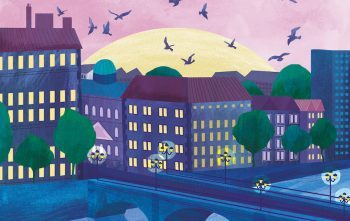Sarah Baxter in Literary Hub:
 The pub is warm and beery. Grog glasses—drained, foam stained—scatter sticky veneer. Red-wine lips, hoppy breath, a slurry of slurring; laughter like gunfire, craic-ing off the wood panels, mirror walls and ranks of whiskey bottles. Bar talk is of theology and adultery, literature and death, soap and sausages. Everything and nothing, discussed or daydreamed over a quick cheese sandwich. A nothing old day. But the stuff of life—infinitesimal yet essential—all the same . . .
The pub is warm and beery. Grog glasses—drained, foam stained—scatter sticky veneer. Red-wine lips, hoppy breath, a slurry of slurring; laughter like gunfire, craic-ing off the wood panels, mirror walls and ranks of whiskey bottles. Bar talk is of theology and adultery, literature and death, soap and sausages. Everything and nothing, discussed or daydreamed over a quick cheese sandwich. A nothing old day. But the stuff of life—infinitesimal yet essential—all the same . . .
James Joyce’s Ulysses—variously considered the most momentous, accomplished, infuriating and unreadable book in the English language—is the ordinary made extraordinary. It’s a modernist reworking of Homer’s Odyssey, but while the Ancient Greek poem tells of Odysseus’ incident-packed return from the Trojan War, Joyce makes an epic out of a single, unremarkable day.
Ulysses follows Leopold Bloom, a Jewish ad canvasser for The Freeman’s Journal, as he wanders around Dublin on June 16, 1904. He attends a funeral, goes to the pub, ducks into a museum (to avoid the man sleeping with his wife), pleasures himself by Sandymount Strand, enters the red-light district. The novel is a chaotic stream of consciousness, performing stylistic acrobatics to try to render the human experience. But it is grounded in the streets of Dublin. Joyce, writing from self-exile in Paris, slavishly researched the physicality of the city. Though he seldom returned, he remained tethered: “When I die,” he once said, “Dublin will be written in my heart.”
More here.
